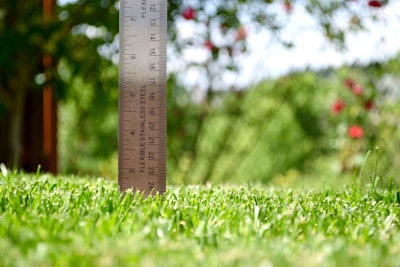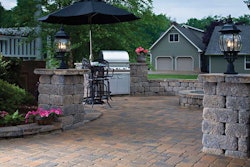 Photo: Grass Seed USA
Photo: Grass Seed USAWhile the approaching summer time will coax more homeowners outdoors with warmer temperatures and longer days, it is important to take advantage of the remaining springtime to prep your clients’ yard for summer stressors.
Turfgrass is resilient and can take a beating but increased temperatures and high foot traffic can make even the hardiest lawn deteriorate if the proper care and precautions are not applied.
While these steps may sound like a broken record to you, you cannot assume your client knows better unless you educate them. This is especially important if you don’t handle their lawn care maintenance.
Mowing
Whether you’re working with cool-season grasses or warm-season grasses, mowing at the tall end of the mowing height can help improve the lawn’s wear tolerance. This allows for more leaf tissue to endure compaction and protects the growing point of the plant.
“I’d start rolling into that now in preparation for the summer,” said Geoff Rinehart with the University of Maryland.
Another important element to keep in mind when it comes to mowing is having sharp blades.
“Especially when we get into the summer, things start to dry out,” Rinehart said. “The grass blades become a little bit tougher to clip. They’ve got less water content in them. Those mower blades can really dull out by midsummer so being able to sharpen the mower blades and avoid fraying the end of the leaf is important.”
This can help prevent diseases that tend to gain entry via frayed grass blades. Sharp blades also result is a much cleaner, neater cut in general. Rinehart adds that cleaning the mower decks out will help the blades spin better.
Watering
While lawns are often portrayed as water-guzzling plots of land that must be irrigated on a daily basis, experts agree turfgrass actually does better when watered deeply and infrequently.
“Sometimes folks will get into where they have their irrigation set for a couple minutes every day and the water really doesn’t move very far into the root zone,” Rinehart said. “It just gets caught up in that upper layer and it’s not getting water down to the roots that are deeper that could better sustain that deeper root system.”
Most cool-season grasses can thrive on about 1 inch of water, with rainfall, per week during the summer and more drought-tolerant grasses need even less. By getting water to the roots that are deeper, there is a better chance of sustaining them over the summer.
Frequent irrigation can also lead to promoting certain turfgrass diseases if the blades are often left wet.
As for why the idea that grass needs frequent watering has been so perpetual, Rinehart believes it’s because of people’s natural tendency is to worry or overmanage. Watering every day also prevents the lawn from having a chance to dry out. This inhibits the amount of air space in the soil.
“The average person doesn’t have a really good understanding of our soil needing air space and not liking it saturated all the time,” Rinehart said. “If it’s saturated all the time, you’re encouraging certain disease pathogens.”
Fertilizing
For cool-season grasses, it is not advisable to fertilize in the summertime, but if applied at the proper time, they can help with stress tolerance.
“With cool-season grasses, you want to time that spring fertilization so it’s after the flush of growth but before things get hot,” Rinehart said. “If you fertilize too late and it starts to get hot, you can actually stimulate brown patch disease within cool-season grasses.”
Rinehart advises opting for slow-release fertilizer because fast-release fertilizer is more likely to cause brown patch.
Meanwhile, mid-spring through summer is the optimal time to fertilize for warm-season grasses like Bermuda grass, zoysiagrass, St. Augustine grass and centipedegrass. This should be started after the turf has completed its spring greening.
Heavy nitrogen fertilization can have a negative effect by causing an excess of spring shoot production and in turn reducing root formation. Weak root systems will become apparent in hot dry summers. If your client wants early-season color, foliar applications of iron can provide greening without an increase in shoot growth. However, this tends to be short-lived.
Best grasses for high traffic areas
Like most things in life, there is no one perfect option but everything has its tradeoffs. For example, Rinehart says that perennial ryegrass has the top wear tolerance, but it doesn’t have very good recuperative capacity because it is a bunch type grass and it is more prone to disease.
Kentucky bluegrass tends to be the cool-season choice for high-traffic, high-performance situations because it has the capacity to recover, yet doesn’t have as much wear tolerance as ryegrass does.
Yet both of these types of grasses are not recommended for residential homes in transition zones, as they are prone to diseases. Growing a warm-season grass for the summer and overseeding with a cool-season grass in the winter can be a solution in this situation.
Meanwhile, warm-season grasses like Bermuda grass boast of a high-traffic tolerance but will struggle to recover if it does get worn out. The same can be said for zoysiagrass. Bahiagrass and centipedegrass, which both spread by stolons, are vulnerable to damage and do not recover well.









